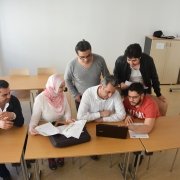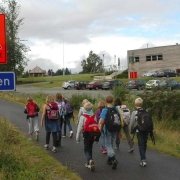Inclusion for real
Excerpt
Inclusion for real is a project within the City of Malmö in Sweden and involves all three departments of education: pre-primary school, primary and secondary school and upper secondary. The overall aim of the project is to guarantee that all school leaders and others in management positions have sufficient knowledge of discrimination legislation as well as the acknowledgement of and critical approach to norms. This is important both from an employee/employer perspective and from an operational perspective. The basis for a common understanding is laid through offering the same training, independent of which department they represent. The training is also offered to a selected number of employees: two process facilitators per school/pre-school. All participants in this project gain basic knowledge about norms and discrimination in order to strengthen their norm-critical skills, both as managers, employees and colleagues. The knowledge gained will influence the work environment for both teachers and pupils. Schools and pre-schools will get step by step instructions and will all have educated process facilitators to support them for an equal education and real inclusion for all.
Narrative, origins and objectives of the initiative
What kind of project is this? Please give a short description (summary) of it.
The project aims to implement norm criticism as a tool to combat discrimination and inequality throughout the school system in Malmo. This is done through teaching the principles of norm criticism to all managers and employees, and through educating 1-2 process leaders in each preschool/school to help implement these principles in the day to day operations as well as to secure the sustainability and endurance of these principles in the long term.
Please tell us why, in general, this project is considered a successful one?
A high demand of the service offered.
The project responds to a perceived need among teachers and school leaders.
The train-the-trainer model secures sustainability.
And why would you consider it a grass-roots initiative?
The idea first emerged at a conference where staff from all three school departments had the opportunity to discuss issues of discrimination and equity. They realised that they had a lot in common and saw the need for more cooperation and a common strategy throughout the school system. This resulted in a proposal to the Director of each department (Pre-School, Primary School and Upper Secondary and Adult Education) who then decided to launch the project.
What challenges needed to be solved in this project?
Time and ownership as well as the fact that working with values and norms is commonly seen as competing with other commitments in schools, rather than something that should be integrated in all aspects of education. The issue of time is therefore commonly raised as in “we don’t have time for this” or “not another project, we’ve already got too many”.
Is this initiative based on any particular theoretical framework? Which one?
The project is based on theories of critical pedagogy and norm criticism. An at-a-glance introduction to norm criticism in English can be found here: https://www.genus.se/en/wordpost/normnormcriticism/ and http://www.includegender.org/facts/norm-criticism/
The training is based on the idea of "Train the trainers" in order to have maximum effect.
(Appendix) Is your intervention standing on its own or is it a part of a bigger and more holistic approach?
It is part of the city of Malmö's strategy for primary education: "The best school for each student".
Please describe the group(s) intended as beneficiaries of this initiative
Why has this group (have these groups) been chosen?
In order to give all children and pupils in Malmö an equal education based on human rights, the project targets school leaders with the mandate to influence the education system. It also aims to educate trainers/process facilitators at each school or preschool (in total approximately 400 institutions) with the task of implementing and visualising a norm critical approach at their school.
Could you please tell us something about the relative size of the (of each) target group, within the school/university population, region and/or country?
Approximately 200 process facilitators, 500 school leaders, 12 000 employees and 57 000 children and pupils are reached through the process facilitators.
Department of Pre-School Education (approximately 300 pre-schools) , Department of Primary Education (approximately 80 schools) and Department of Upper Secondary and Adult Education (approximately 20 schools and colleges).
Which social characteristics are taken into account and what is the geographical area covered?
The city of Malmö is an international and multicultural city with approximately 330 000 inhabitants, and it is constantly growing. The city has had a large influx of newly-arrived refugees and immigrants, which has put pressure on the educational system. Malmö is a rather segregated city with areas facing many socio-economical challenges. This segregation is mirrored in the schools, hence it was important that this project included all schools in Malmö.
On which level is the project implemented?
At city level: The Department of Primary Education.
Please describe the political and socio-economic factors that you believe have been important enablers for your initiative
Did the initiative have political support?
Yes, because the city of Malmö is politically run.
How did it fit with local, regional or national policies?
In 2017 the Discrimination Act was updated in Sweden to include a requirement for active measures. These are prevention and promotion measures aimed at preventing discrimination and serving in other ways to promote equal rights and opportunities. Employers and educators are required to take active measures to prevent discrimination on all grounds covered by the Discrimination Act: gender, transgender identity or expression, ethnicity, religion or other belief, disability, sexual orientation and age. One of the most frequently recommended tools for this, for example by the Swedish Ministry for Education and Research, is a norm critical approach.
Who are the stakeholders supporting the initiative?
The Directors of the Departments: Department of Pre-School Education, Department of Primary Education and Department of Upper Secondary and Adult Education, as well as The Steering Group of the Department for Pedagogical Development.
Are there particular demographic changes present that are influencing the project?
No
What is the institutional strategy and culture of the (educational) organization?
There is huge interest in raising issues concerning all types of discrimination, but sometimes little knowledge about how to act in practice. The culture has been dominated by single actions, and has, until now, not strived to be included in the daily work. This is an attempt to make a strategy that influences all levels of education.
To what extent does the initiative have an influence on institutional policy (or potential influence) of the (educational) organization?
To a very high extent. Other departments have seen the need for their staff to also be educated in norm criticism, for example the HR department. The Department of Pre-School Education has requested that all of their development teams (groups of pedagogues tasked with guiding the pedagogical development in Pre-Schools) receive the same education as the process facilitators.
(Appendix) Is there public support for your initiative and the issue it addresses?
There is support for inclusive education but the concept of norm critical pedagogy is sometimes debated.
(Appendix) What other factors do you think have been important for the success of this initiative?
The high demand from school leaders, the systematic approach and how it relates to everyday issues for teachers. A clear directive and follow-up requirements from the management made it easier for school leaders to prioritize the project. In addition, it was clearly stated that it is the responsibility of the school leaders to lead and own the process with support from the process facilitators. This prevented the project from being dependent on a few committed individual who neither have the mandate nor the resources to implement the work method.
Please describe the overall initiative design and the methods and tools used to reach the goals
Please describe the specific activities carried out.
Managers are educated in the Discrimination Act with special attention given to the active measures. Every manager is then tasked with educating his or her entire staff on the principles of a norm critical approach. This is carried out through short lectures and discussions during staff meetings based on material provided by HR. If the manager already has a process leader, they can help with this part.
The course for the process leaders, Inkludering på riktigt, includes five half-days of training, with materials (books, articles, films) to study and reflect on before each training. These five days cover the historical background and terminology of the field, contrast between a norm critical approach and the tolerance perspective (see Kevin Kumashiro), a study of common norms and privileges on a structural level, power and resistance techniques (like master suppression techniques), and tools for implementation. The assessment is to write a suggestion on how to start the work in their own organization based on a baseline analysis.
What were the key roles (teacher, student, management team etc.) within the project?
Managers and process facilitators.
What ideas, tools, theories, models, methodology (etc.) have been used to reach the goals?
The didactic idea of the course is to mix theoretical content with personal experience (through exercises and reflections) and structured conversations with colleagues to simultaneously teach the subject matter and give tools on how to carry this knowledge to their respective work places. We use the methodology commonly used in schools today of flipped classroom, drama pedagogy, formative assessment and cooperative learning.
What are the final revenues of the project?
The project is still ongoing.
Please describe if your project ensured its sustainability
If so, how did you ensure the short-term impact of the project?
The competence is transferred into the schools by the train-the-trainer model.
And how did you ensure the long-term impact of the project?
By securing the role of the process facilitators and by expanding the target group to include school leaders and HR specialists.
Has your project been replicated elsewhere?
Not to our knowledge
Please tell us about the resources used in this initiative
What was the budget for the initiative?
Cost of Staff (educators): 1,5 full-time staff = 750 000 SEK
Cost of Staff (participants): 5 days for 4 hours + study time = 40 hours/participant = 15 000 SEK/participant. 200 participants * 15 000 SEK = 3 000 000 SEK (already covered by the annual salary)
Literature: App 500 SEK/participant = 10 000 SEK
Total: 3 760 000 SEK
How much did the initiative depend on volunteers?
Nothing at all
How were the costs perceived by the public/the sector/other stakeholders?
The costs are not very known so this is difficult to comment.
To what extent did the initiative achieve its objectives?
Please describe the evidence to support the success of your initiative.
The evaluation from teachers tells us that the education is responding to their perceived needs.
Did the intervention lead to any unintended (positive) outcomes?
Better communication within groups of staff, a shared language.
What indicators (quantitative and qualitative) have you measured to demonstrate success?
The project is ongoing and has not yet been fully evaluated. A bigger evaluation will be done in 2019.
(Appendix) How did you evaluate/monitor this intervention?
Each session is evaluated. The project as such is evaluated by an ongoing dialogue together with a group of researchers.


 Copyright: Camilla Pellech, Postgraduate Center der Universität
Copyright: Camilla Pellech, Postgraduate Center der Universität



 Interkulturelles Mentoring
Interkulturelles Mentoring